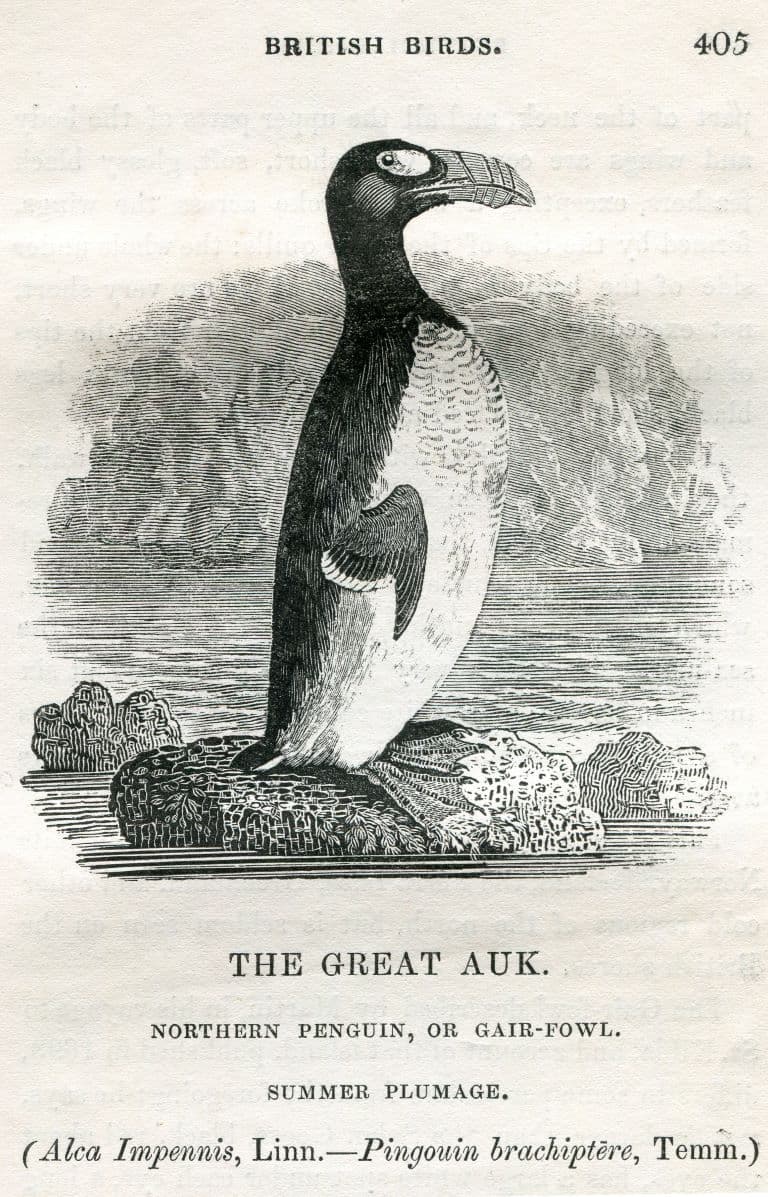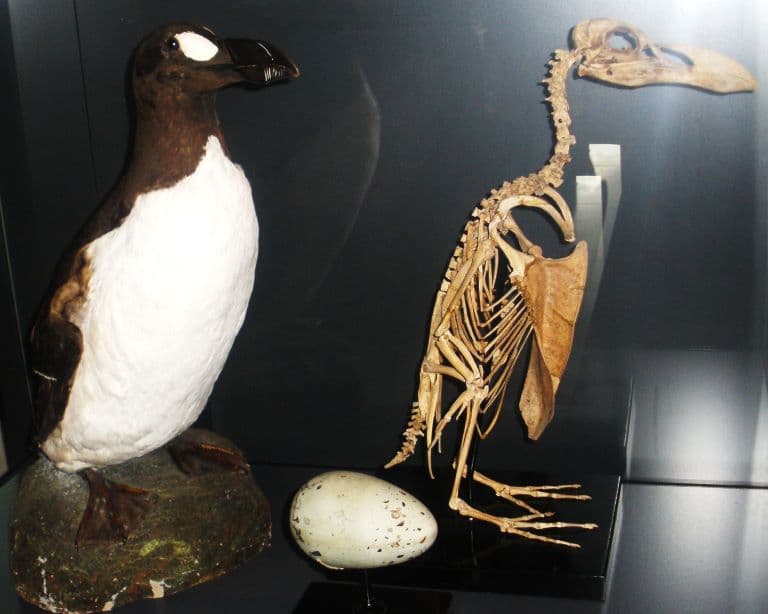Great Auk Profile
Some animals’ names are onomatopoeic. The cuckoo, the dik-dik, and the hoopoe are good examples. Some names go a step further and represent the sound an animal presumably made as its species was snuffed from existence by a fisherman’s boot. The Great Auk is the sound of yet another tragedy at the hands (and feet) of human invaders.

Great Auk Facts Overview
| Habitat: | Rocky Islands |
| Location: | The Atlantic from Canada to Scandinavia, down to Southern Europe |
| Lifespan: | 20-30 years |
| Size: | 85cm (33 inches) tall |
| Weight: | Up to 5kg (11lb) |
| Colour: | Black, with white belly |
| Diet: | Fish |
| Predators: | Humans, orca, seals |
| Top Speed: | Unknown |
| No. of Species: | 1 |
| Conservation Status: | Extinct |
Great Auks were doing pretty well as the original penguins for millions of years, even alongside multiple species of humans as a food source and a likely inspiration for unknown ceremonies and spiritual practices.
They occupied a niche very similar to the penguins we all know today and were agile predators of fish. They once gathered on islands in huge numbers, but with the population boom of humans in modern civilisations, they didn’t stand a chance.
Their meat, feathers and eggs were all sought after, and despite rudimentary protection efforts, they disappeared before even the middle of the 19th century.
Interesting Great Auk Facts
1. The original Penguin
Despite looking very much like a penguin (and having a very penguin scientific name): flightless, black and white, short, fin-like wings, etc., the Auks are a family of sea birds from a totally different order, sharing a space with gulls and waders.
However, penguins as we know them got their name from this bird, as they would have been discovered to modern science by explorers from the Northern Hemisphere. In contrast, the Auk was so familiar that it was never formally described or studied, and the only records come from common sources.
The Auks were well known to the Northerners for thousands of years – as we’ll discuss – so upon venturing to the Arctic, it’s only natural that the Auk-like birds they found would have been compared to them.
But, penguins are a Southern Hemisphere lot, so it stands to reason that their niche in the North was relatively unoccupied, which may be why and how the great Auks were moulded by evolution to look very much like penguins. Sadly, they haven’t fared as well.
There are still a lot of Auks about, all of whom can fly, which probably gives you a clue as to why they’re still about.
The great Auk was a much more penguin-like animal, and while the remaining family members are pretty well adapted to ocean life, this one was a master of it. 1

2. They were good divers
It’s said that they predominantly occupied remote islands with lots of fish, and, being a flightless waddler, they were more than ready to exploit these resources.
The great Auk would breed relatively far North in the Atlantic, and would often over-winter in the North Sea, but they were also somewhat migratory and remains and records show us that they would sometimes travel South to the Med’ for a break between breeding seasons.
Their bodies were streamlined and muscular, just as with penguins, and for the same reason – they were expert divers. Supposedly, Great Auks could descend to 75 meters in pursuit of fish. However, it’s also said by some they could reach a kilometre down, and it’s worth remembering that none of this is substantiated.
The powerful black beak was grooved for grip, and the wings were short, for guiding and propelling the bird through the water.
3. They bred in rare hotspots
These breeding grounds with lots of fish were not so easy to come by, and there are only a handful of sites across the Great Auk’s range that have been thought to house colonies.
And so it’s hardly surprising that colonies were said to be hundreds of thousands of birds thick, and in at least one instance would be entirely covered with the birds, such that, as a sailor wrote in 1718, “a man could not put his foot between them”. 2

4. Auks played a significant role in ancient human culture
Humans and Great Auks used to go way back. 6000 years ago, the settlers in what is now Scandinavia would have stumbled across populations of these birds in the millions, and would have been quick to take advantage of this new source of protein.
One human burial site in Newfoundland from 4000 years ago brought up more than 200 Great Auk beaks as part of ceremonial clothing, suggesting a deeper relationship between the two species.
Similar discoveries have been found in Native American and Palaeolithic European archaeological sites.
Even Neanderthals had a hankering for great Auk meat as far back as 100,000 years ago, as evidenced by the KFC-like wing bones left around the fireplace in archaeological discoveries.
This history would eventually shift, as the ratio of humans to Great Auks began to swing the other way.
5. The little ice age brought polar bears
It wasn’t only humans who were responsible for their decline. As they nested in Northerly regions, a period of unseasonable coldness may have bridged the gap between their islands and the mainland with sea ice.
Between the 14th and 19th century, the region cooled significantly, and it has been suggested that other predators may have gained new access to the Great Auk colonies during this period.
While this is a possibility, they likely didn’t suffer too many losses as a result of this. There was a much more serious threat on the horizon. 3
6. Humans did their bit too, though
Before the 16th century, colonies such as those previously described would have been common sights on the breeding islands of the North Atlantic.
But by the mid-16th century, the European populations were more or less gone; wiped clean by the rapid and accelerated hunting of the species for its feathers.
On the other side of the pond, a reduction in eider ducks (for the same reason) opened up a market for great Auk feathers, and thus the pattern continued.
Their fat, their eggs, and even their feet were popular among a growing human population and by the late 1700s, the species was in real danger.
While it received its first official protection in 1553, it wasn’t until 1794 (or 1775, depending on the source) that the Brits banned the killing of the bird after a petition from the Nova Scotian government, and there are records of public floggings imposed upon those who broke this law.
Though, fishermen were still allowed to kill them as bait.
Frustratingly, the increasing rarity of the bird led to an increase in interest in its products.
7. They were even massacred for science
A drop in numbers led to a jump in price for great Auk eggs, and pillow-makers gave way to egg collectors as a primary perpetrator of the bird’s decline.
Museums began taking an interest in the rare species, further contributing to the market for eggs and specimens in the name of preservation.

8. They were stamped out
Records suggest that two of the last individuals on Earth were killed by sailors in 1840. On land, it was a trivial matter to catch up with and kidnap such a waddling, fearless animal.
On the return route, a large storm threatened the voyage, and being 19th-century sailors, superstition may have gotten the better of the men onboard.
In classic human fashion, the birds were accused of witchcraft and stoned to death.
Within about four years, the species was extinct. The last record comes from an account of a breeding pair, incubating and egg, being ruthlessly hunted and killed by fishermen.
The egg was crushed by a boot in the scuffle, ending forever an unbroken line of 3.4 billion years of reproduction.
It’s unknown why exactly this hunt went ahead. Some say it was a business transaction, others blame a similar case of superstition in which the birds were accused of causing a storm. Either way, that was the last time anyone saw a live Great Auk. 4
Great Auk Fact-File Summary
Scientific Classification
| Kingdom: | Animalia |
| Phylum: | Chordata |
| Class: | Aves |
| Order: | Charadriiformes |
| Family: | Alcidae |
| Genus: | Pinguinus |
| Species: | impennis |
Fact Sources & References
- “The original penguin (for the great auk)”, Among the Stately Trees.
- Samantha Galasso (2014), “When the Last of the Great Auks Died, It Was by the Crush of a Fisherman’s Boot”, Smithsonian Magazine.
- “The extinction of The Great Auk”, Audubon.
- “Jul 3, 1844 CE: Great Auks Become Extinct”, National Geographic.
